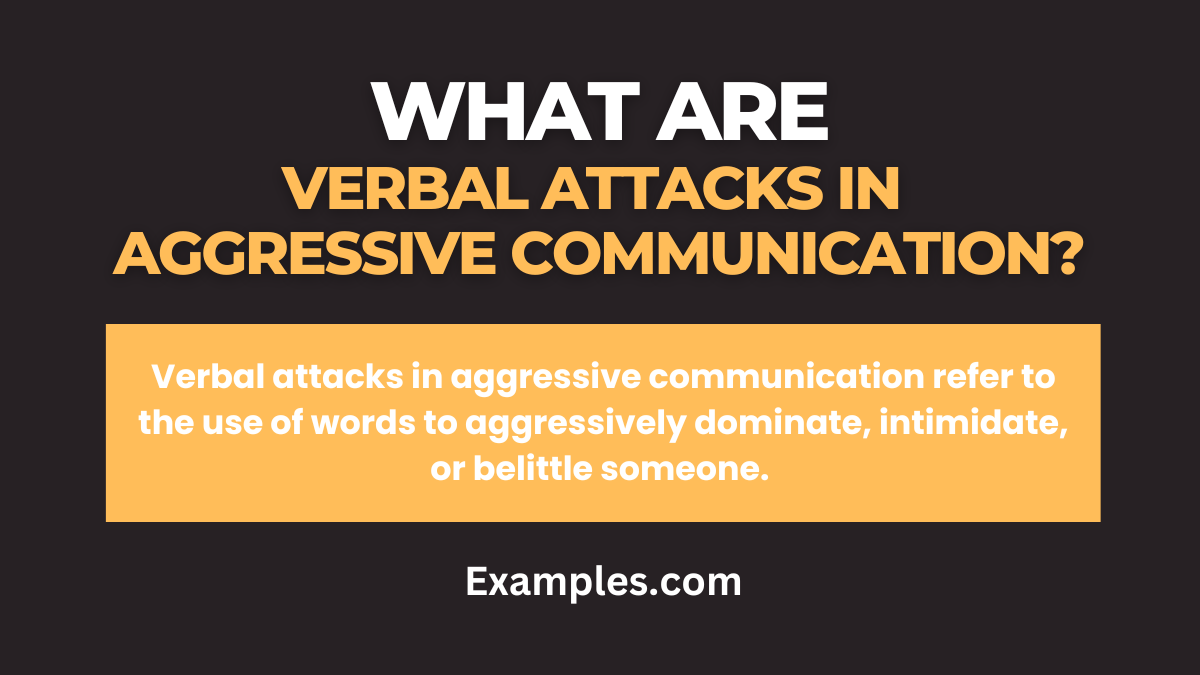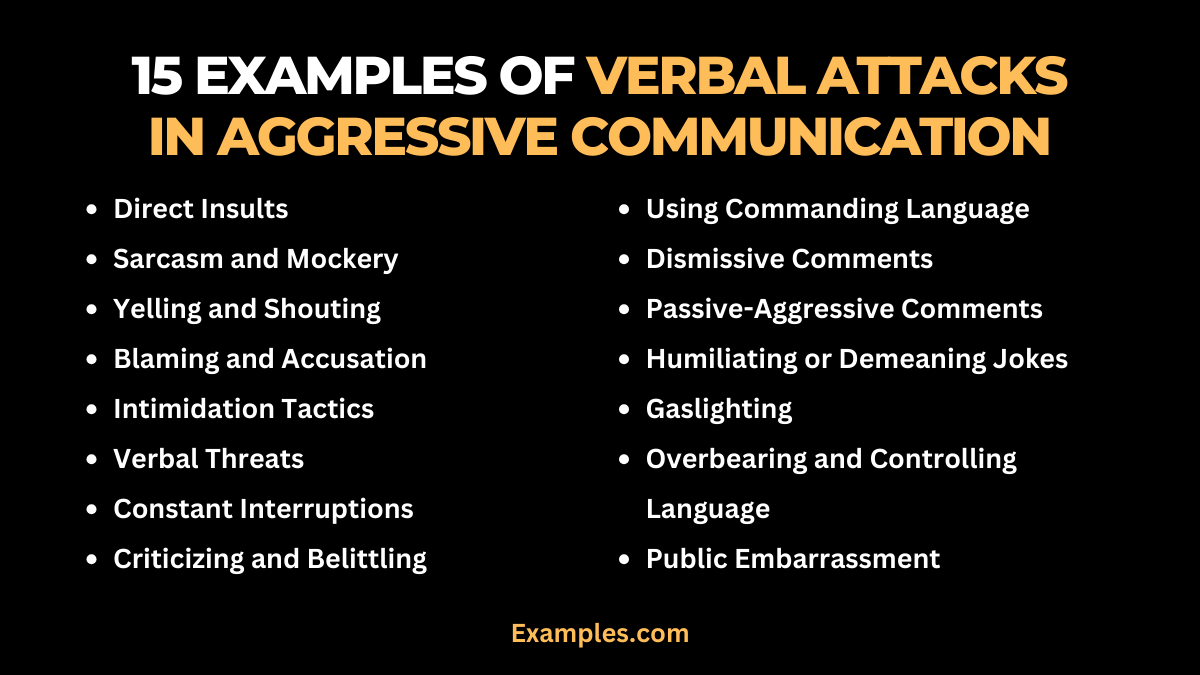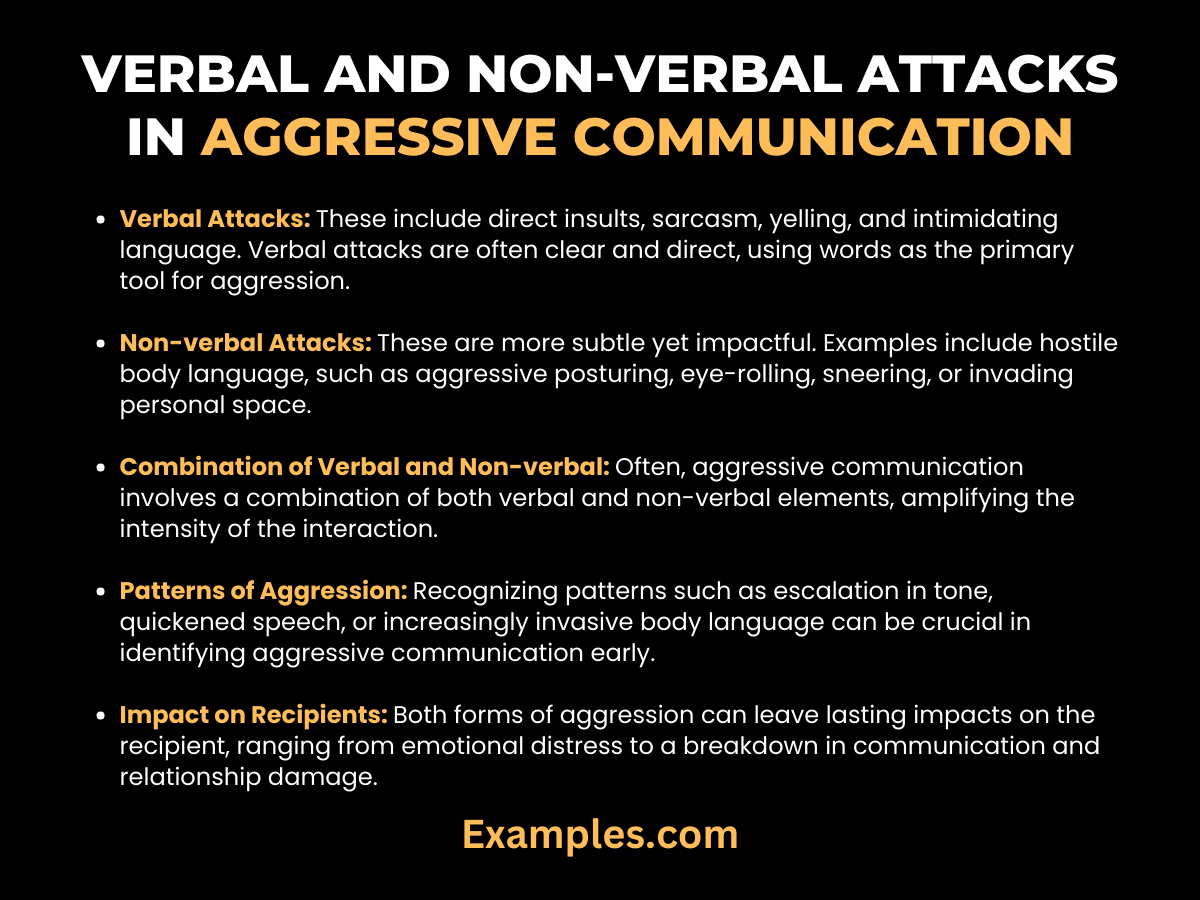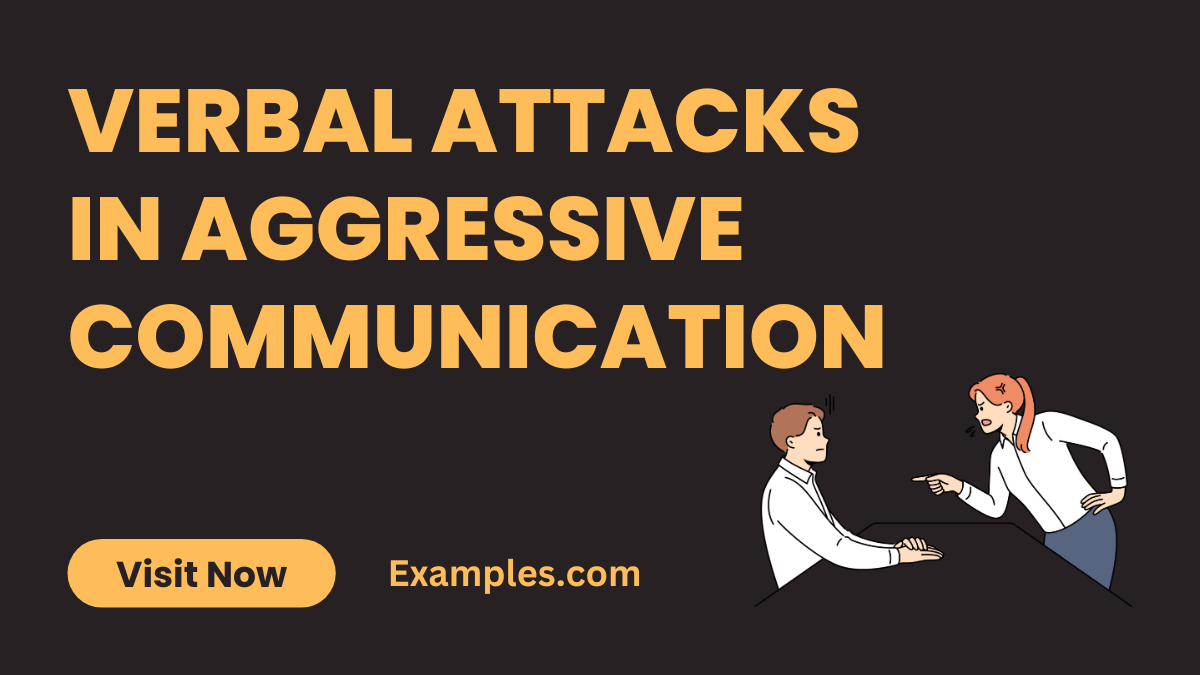14+ Verbal Attacks in Aggressive Communication Examples
Navigate the complex terrain of Verbal Attacks in Aggressive Communication with this detailed guide. Packed with insights and Aggressive Communication Examples, it offers a deep dive into understanding, identifying, and effectively responding to verbal aggression. Whether in the workplace, at home, or in social interactions, this guide provides valuable strategies and sentence examples to help you deal with verbal aggression in a constructive and assertive manner.
What are Verbal Attacks in Aggressive Communication?

Verbal attacks in aggressive communication refer to the use of words to aggressively dominate, intimidate, or belittle someone. This can include shouting, insulting, blaming, or using sarcastic and critical language. It’s a form of communication where the speaker uses words to harm, control, or overpower the listener, often leading to negative and hostile interactions.
15 Examples of Verbal Attacks in Aggressive Communication
Verbal attacks in aggressive communication manifest in various forms, often impacting relationships and communication dynamics significantly. This guide outlines 15 distinct examples of verbal aggression, each accompanied by a detailed explanation and a communication example. These scenarios will help you identify and understand aggressive verbal behaviors, providing insights into how they occur in everyday interactions and Aggressive Communication Examples.

- Direct Insults: Using derogatory or demeaning language aimed at belittling the recipient.
Example: In a heated argument, one person may call the other “stupid” or “worthless,” directly attacking their character or intelligence. - Sarcasm and Mockery: Employing sarcasm or mocking tones to undermine or ridicule someone.
Example: During a team meeting, a manager sarcastically says, “Great job on missing all your deadlines,” publicly humiliating a team member. - Yelling and Shouting: Raising the voice aggressively during conversations.
Example: A parent yelling at their child, “You never listen to me!” escalating a simple discussion into a hostile situation. - Blaming and Accusation: Shifting responsibility and fault to others aggressively.
Example: In a project review, a team leader aggressively blames a colleague, saying, “This failure is entirely your fault!” - Intimidation Tactics: Using words to intimidate or instill fear.
Example: A boss telling an employee, “If you don’t get this right, consider your job gone,” creating a threatening environment. - Verbal Threats: Making statements that threaten harm or negative consequences.
Example: During an argument, someone might say, “If you don’t agree with me, you’ll regret it.” - Constant Interruptions: Repeatedly interrupting someone to dominate the conversation.
Example: In a debate, one person consistently cuts off the other, not allowing them to complete their points. - Criticizing and Belittling: Constantly finding faults and making someone feel inferior.
Example: A partner continually criticizes their spouse’s cooking, saying, “You can’t do anything right.” - Using Commanding Language: Employing a dictatorial tone and language.
Example: A manager orders their team, “Do as I say without questioning!” - Dismissive Comments: Making remarks that dismiss or invalidate someone’s thoughts or feelings.
Example: When an employee shares an idea, their colleague dismissively says, “That’s a silly thought.” - Passive-Aggressive Comments: Indirectly expressing aggression through seemingly passive remarks.
Example: “I’m not surprised you missed the detail, you’re always so careless,” said in a tone that hides direct confrontation. - Humiliating or Demeaning Jokes: Using humor to degrade or embarrass someone.
Example: Making a joke about a colleague’s accent in a team gathering to belittle them. - Gaslighting: Manipulating someone into questioning their own reality or sanity.
Example: Telling a person, “You’re overreacting, that never happened,” to undermine their experience. - Overbearing and Controlling Language: Dominating the conversation to control the outcome.
Example: In a discussion, one person forcefully imposes their opinion, disregarding others’ views. - Public Embarrassment: Deliberately embarrassing someone in front of others.
Example: A teacher reprimanding a student in a demeaning manner in front of the class.
Verbal and Non-verbal Attacks in Aggressive Communication
In the realm of Aggressive Communication, both verbal and non-verbal attacks play significant roles. Understanding these forms of aggression is key to navigating and managing interactions effectively, especially in high-tension environments. This guide explores the nuances of verbal and non-verbal attacks in aggressive communication, offering insights into their impact and manifestations.

- Verbal Attacks: These include direct insults, sarcasm, yelling, and intimidating language. Verbal attacks are often clear and direct, using words as the primary tool for aggression.
- Non-verbal Attacks: These are more subtle yet impactful. Examples include hostile body language, such as aggressive posturing, eye-rolling, sneering, or invading personal space.
- Combination of Verbal and Non-verbal: Often, aggressive communication involves a combination of both verbal and non-verbal elements, amplifying the intensity of the interaction.
- Patterns of Aggression: Recognizing patterns such as escalation in tone, quickened speech, or increasingly invasive body language can be crucial in identifying aggressive communication early.
- Impact on Recipients: Both forms of aggression can leave lasting impacts on the recipient, ranging from emotional distress to a breakdown in communication and relationship damage.
Preventing Verbal Attacks in Aggressive Communication Scenarios
Preventing verbal attacks in aggressive communication scenarios is crucial for maintaining a healthy and respectful communication environment. This guide provides strategies and tips for identifying and mitigating the risks of verbal aggression, essential for anyone facing potential confrontations or high-stress communication situations.
- Fostering Open Communication: Creating an atmosphere where open, respectful dialogue is encouraged can preemptively reduce the likelihood of verbal attacks.
- Setting Clear Boundaries: Establishing clear boundaries regarding acceptable communication behaviors can deter aggressive verbal interactions.
- Developing Emotional Intelligence: Understanding and managing one’s emotions, as well as empathizing with others, can prevent escalation into verbal aggression.
- Conflict Resolution Skills: Equipping oneself with conflict resolution skills can help in de-escalating potentially aggressive situations before they lead to verbal attacks.
- Encouraging Active Listening: Promoting active listening within teams or in personal interactions can ensure all parties feel heard, reducing frustrations that can lead to verbal aggression.
- Awareness of Triggers: Being aware of personal and environmental triggers that can lead to aggression can help in managing responses and avoiding verbal attacks.
- Role of Leadership: In organizational settings, the role of leadership is pivotal in setting the tone for communication and addressing aggressive behaviors promptly and effectively.
- Training and Workshops: Participating in communication and conflict management workshops can provide individuals with the tools to prevent verbal aggression.
- Modeling Respectful Behavior: Leading by example and demonstrating respectful and calm communication can set a positive precedent.
- Seeking Professional Help: In cases where aggression is a recurring problem, seeking professional help or counseling can be a beneficial step.
What are the Common Forms and Patterns of Verbal Attacks in Aggressive Communication?
In the landscape of Aggressive Communication, verbal attacks can take various forms and follow certain patterns. Recognizing these can be crucial in understanding and managing aggressive interactions, whether in personal relationships, the workplace, or other settings. This guide delves into the common forms and patterns of verbal aggression, providing insights into the nature of these attacks and how they manifest in communication.
- Direct Insults and Name-Calling: One of the most overt forms of verbal aggression, involving outright derogatory remarks and personal attacks.
- Sarcasm and Mockery: Using sarcastic comments or mocking tones to demean or belittle the recipient, often veiling aggression under the guise of humor.
- Yelling and Raised Voices: Characterized by an increased volume and aggressive tone, this form seeks to intimidate or dominate the recipient.
- Blaming and Finger-Pointing: Assigning fault and responsibility to others in an aggressive manner, often to deflect blame from oneself.
- Intimidation through Language: Using words to create fear or submission, often involving threats or coercive language.
- Frequent Interruptions: Continuously cutting off the other person to assert control over the conversation and prevent them from expressing their views.
- Belittling and Dismissive Remarks: Making comments that trivialize or undermine the other person’s opinions, feelings, or contributions.
- Passive-Aggressive Communication: Indirectly expressing hostility or aggression, often through backhanded compliments or subtle digs.
- Gaslighting: Manipulating the other person to question their reality, perceptions, or sanity, thereby exerting control and dominance.
- Hostile Questioning: Bombarding someone with aggressive and accusatory questions, often without giving them a chance to fully respond.



